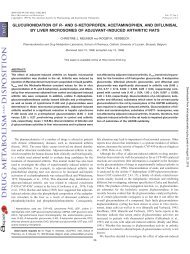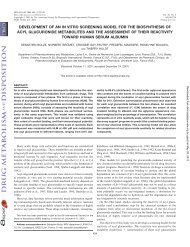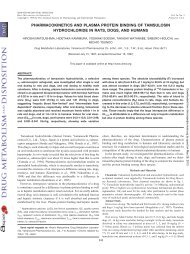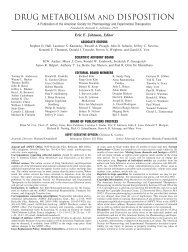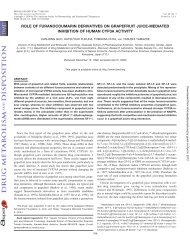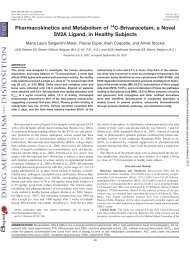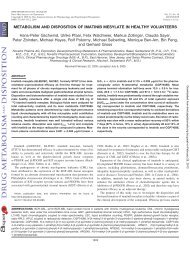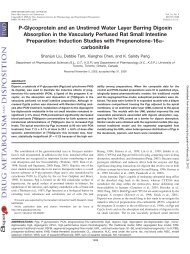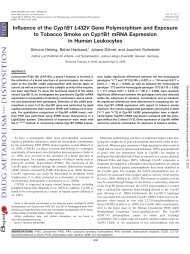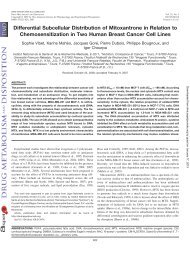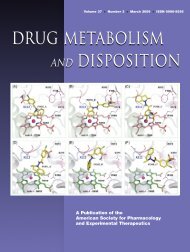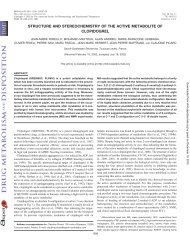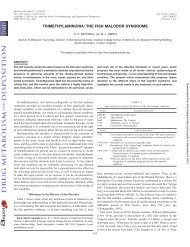In Vitro Glucuronidation of Thyroxine and Triiodothyronine by Liver ...
In Vitro Glucuronidation of Thyroxine and Triiodothyronine by Liver ...
In Vitro Glucuronidation of Thyroxine and Triiodothyronine by Liver ...
Create successful ePaper yourself
Turn your PDF publications into a flip-book with our unique Google optimized e-Paper software.
2210 TONG ET AL.<br />
conjugation <strong>of</strong> T3 was catalyzed <strong>by</strong> UGT2B2. That activity was<br />
detected with multiple human UGT is<strong>of</strong>orms in the present study<br />
might be attributed to overlapping substrate specificity for UGTs<br />
(Radominska-P<strong>and</strong>ya et al., 1999). Formation <strong>of</strong> the acyl glucuronides<br />
<strong>of</strong> thyroid hormones <strong>by</strong> UGT is<strong>of</strong>orms has not previously been<br />
reported. However, at least six human UGTs—UGT1A1, UGT1A3,<br />
UGT1A8, UGT1A9, UGT1A10, <strong>and</strong> UGT2B7—have been identified<br />
catalyzing the glucuronidation <strong>of</strong> carboxylic drugs (Gall et al., 1999;<br />
Mackenzie, 2000; Sallustio et al., 2000). These UGTs also catalyze<br />
the glucuronidation <strong>of</strong> a number <strong>of</strong> noncarboxylic acid compounds,<br />
including both endogenous <strong>and</strong> xenobiotic chemicals, <strong>and</strong> have overlapping<br />
but different substrate specificities (Sallustio et al., 2000).<br />
Significant differences in relative specificities toward the same carboxylic<br />
acid substrates have been shown (Sallustio et al., 2000).<br />
Formation <strong>of</strong> acyl glucuronides <strong>of</strong> T4 <strong>and</strong> T3 <strong>by</strong> UGT1A8, UGT1A9,<br />
or UGT1A10 was not observed in the present study. UGT1A4, which<br />
conjugates a structurally diverse group <strong>of</strong> compounds including drugs,<br />
xenobiotics, hydroxysteroids, <strong>and</strong> particularly primary, secondary,<br />
<strong>and</strong> tertiary amine-containing compounds (Green et al., 1995; Green<br />
<strong>and</strong> Tephly, 1996), yielded the acyl but not the phenolic glucuronide<br />
<strong>of</strong> T4 <strong>and</strong> T3. Because UGT1A7, UGT1A8, <strong>and</strong> UGT1A10 are<br />
extrahepatic enzymes (Strassburg et al., 1997, 1999), UGT1A1 <strong>and</strong><br />
UGT1A3, which are expressed in human liver, may play major roles<br />
in T4 glucuronidation in humans.<br />
Species differences in glucuronidation <strong>of</strong> T4 <strong>and</strong> T3 were also<br />
observed under the experimental conditions. Mice have much higher<br />
activity toward T4 than any other species, whereas rats have the<br />
highest activity toward T3 among all the species examined. Female<br />
rats show higher T3 UGT activity than male rats. The yields <strong>of</strong> T3<br />
phenolic glucuronide were lower, whereas the acyl glucuronides <strong>of</strong><br />
both T4 <strong>and</strong> T3 were formed in higher amounts in humans among the<br />
species examined. Species <strong>and</strong> sex differences in UGT activities<br />
toward thyroid hormones have not been well documented, although<br />
species differences in response to chemical inducers have been reported<br />
(Craft et al., 2002; Kato et al., 2003).<br />
<strong>In</strong> summary, a novel LC/MS method was developed to separate <strong>and</strong><br />
detect the phenolic <strong>and</strong> acyl glucuronides <strong>of</strong> T4 <strong>and</strong> T3. This method<br />
was used to evaluate a number <strong>of</strong> UGT is<strong>of</strong>orms for formation <strong>of</strong> the<br />
phenolic <strong>and</strong> acyl glucuronides <strong>of</strong> T4 <strong>and</strong> T3 to study species differences<br />
in T4 <strong>and</strong> T3 glucuronidation in liver microsomes <strong>of</strong> animals<br />
<strong>and</strong> humans. Among the 11 UGT is<strong>of</strong>orms examined, UGT1A1,<br />
UGT1A3, UGT1A8, UGT1A10, <strong>and</strong> UGT2B4 were the major is<strong>of</strong>orms<br />
responsible for the formation <strong>of</strong> T4 phenolic glucuronide,<br />
whereas UGT1A1, UGT1A3, UGT1A8, <strong>and</strong> UGT1A10 catalyzed the<br />
formation <strong>of</strong> T3 phenolic glucuronide. UGT1A3 was the major is<strong>of</strong>orm<br />
responsible for the formation <strong>of</strong> the acyl glucuronides <strong>of</strong> T4 <strong>and</strong><br />
T3. The activity in formation <strong>of</strong> T4 <strong>and</strong> T3 phenolic glucuronide was<br />
lower, whereas the activity in formation <strong>of</strong> T4 <strong>and</strong> T3 acyl glucuronides<br />
was higher in human liver microsomes than in other species.<br />
Acknowledgments. We thank Li Shen for her suggestions <strong>and</strong> help<br />
in the literature search, Lisa Nogle for her help in the NMR analysis,<br />
<strong>and</strong> Theresa Hultin <strong>and</strong> JoAnn Scatina for supporting this research<br />
<strong>and</strong> reviewing the manuscript.<br />
References<br />
FIG. 11. Species comparison <strong>of</strong> T3 glucuronidation. Data represent the average <strong>of</strong><br />
duplicate experiments.<br />
Craft ES, DeVito MJ, <strong>and</strong> Cr<strong>of</strong>ton KM (2002) Comparative responsiveness <strong>of</strong> hypothyroxinemia<br />
<strong>and</strong> hepatic enzyme induction in Long-Evans rats versus C57BL/6J mice exposed to TCDDlike<br />
<strong>and</strong> phenobarbital-like polychlorinated biphenyl congeners. Toxicol Sci 68:372–380.<br />
Croasmun W <strong>and</strong> Carlson R (1994) Two-Dimensional NMR Spectroscopy, VCH Publishers,<br />
Weinheim, Germany.<br />
Dickinson RG <strong>and</strong> King AR (1989) Reactivity considerations in the analysis <strong>of</strong> glucuronide <strong>and</strong><br />
sulfate conjugates <strong>of</strong> diflunisal. Ther Drug Monit 11:712–720.<br />
Findlay KA, Kaptein E, Visser TJ, <strong>and</strong> Burchell B (2000) Characterization <strong>of</strong> the uridine<br />
diphosphate-glucuronosyltransferase-catalyzing thyroid hormone glucuronidation in man.<br />
J Clin Endocrinol Metab 85:2879–2883.<br />
Gall WE, Zawada G, Mojarrabi B, Tephly TR, Green MD, C<strong>of</strong>fman BL, Mackenzie PI, <strong>and</strong><br />
Radominska-P<strong>and</strong>ya A (1999) Differential glucuronidation <strong>of</strong> bile acids, <strong>and</strong>rogens <strong>and</strong><br />
estrogens <strong>by</strong> human UGT1A3 <strong>and</strong> 2B7. J Steroid Biochem Mol Biol 70:101–108.<br />
Green MD, Bishop WP, <strong>and</strong> Tephly TR (1995) Expressed human Ugt1.4 protein catalyzes the<br />
formation <strong>of</strong> quaternary ammonium-linked glucuronides. Drug Metab Dispos 23:299–302.<br />
Green MD <strong>and</strong> Tephly TR (1996) <strong>Glucuronidation</strong> <strong>of</strong> amines <strong>and</strong> hydroxylated xenobiotics <strong>and</strong><br />
endobiotics catalyzed <strong>by</strong> expressed human Ugt1.4 protein. Drug Metab Dispos 24:356–363.<br />
Jemnitz K <strong>and</strong> Vereczkey L (1996) Ion-pair high-performance liquid chromatographic separation<br />
<strong>of</strong> two thyroxine glucuronides formed <strong>by</strong> rat liver microsomes. J Chromatogr B 681:385–389.<br />
Kato Y, Haraguchi K, Yamazaki T, Ito Y, Miyajima S, Nemoto K, Koga N, Kimura R, <strong>and</strong><br />
Degawa M (2003) Effects <strong>of</strong> polychlorinated biphenyls, Kanechlor-500, on serum thyroid<br />
hormone levels in rats <strong>and</strong> mice. Toxicol Sci 72:235–241.<br />
Köhrle J, Brabant G, <strong>and</strong> Hesch RD (1987) Metabolism <strong>of</strong> thyroid hormones. Horm Res<br />
26:58–78.<br />
Mackenzie PI (2000) Identification <strong>of</strong> uridine diphosphate glucuronosyltransferases involved in<br />
the metabolism <strong>and</strong> clearance <strong>of</strong> mycophenolic acid. Ther Drug Monit 22:10–13.<br />
McGurk KA, Remmel RP, Hosagrahara VP, Tosh D, <strong>and</strong> Burchell B (1996) Reactivity <strong>of</strong><br />
mefenamic acid 1-O-acyl glucuronide with proteins in vitro <strong>and</strong> ex vivo. Drug Metab Dispos<br />
24:842–849.<br />
Radominska-P<strong>and</strong>ya A, Czernik PJ, Little JM, Battaglia E, <strong>and</strong> Mackenzie PI (1999) Structural<br />
<strong>and</strong> functional studies <strong>of</strong> UDP-glucuronosyltransferases. Drug Metab Rev 31:817–899.<br />
Saito K, Kaneko H, Sato K, Yoshitake A, <strong>and</strong> Yamada H (1991) Hepatic UDPglucuronosyltransferase(s)<br />
activity toward thyroid hormones in rats: induction <strong>and</strong> effects on<br />
serum thyroid hormone levels following treatment with various enzyme inducers. Toxicol Appl<br />
Pharmacol 111:99–106.<br />
Sallustio BC, Sabordo L, Evans AM, <strong>and</strong> Nation RL (2000) Hepatic disposition <strong>of</strong> electrophilic<br />
acyl glucuronide conjugates. Curr Drug Metab 1:163–180.<br />
Sekikawa H, Yagi N, Lin ET, <strong>and</strong> Benet LZ (1995) Apparent intramolecular acyl migration <strong>and</strong><br />
hydrolysis <strong>of</strong> furosemide glucuronide in aqueous solution. Biol Pharm Bull 18:134–139.<br />
Shipkova M, Strassburg C, Braun F, Streit F, Grone H-J, Armstrong V, Tukey R, Oellerich M,<br />
<strong>and</strong> Wiel<strong>and</strong> E (2001) Glucuronide <strong>and</strong> glucoside conjugation <strong>of</strong> mycophenolic acid <strong>by</strong> human<br />
liver, kidney <strong>and</strong> intestinal microsomes. Br J Pharmacol 132:1027–1034.<br />
Smith PC <strong>and</strong> Liu JH (1993) Covalent binding <strong>of</strong> supr<strong>of</strong>en acyl glucuronide to albumin in vitro.<br />
Xenobiotica 23:337–348.<br />
Spahn-Langguth H <strong>and</strong> Benet LZ (1992) Active <strong>and</strong> reactive phase-II metabolites: the glucuronides<br />
pathway, in Top Pharm Sci 1991 (Crommelin DJA <strong>and</strong> Midha KK eds) pp 505–516,<br />
Medpharm Scientific Publishers, Stuttgart, Germany.<br />
Strassburg CP, Nguyen N, Manns MP, <strong>and</strong> Tukey RH (1999) UDP-glucuronosyltransferase<br />
activity in human liver <strong>and</strong> colon. Gastroenterology 116:149–160.<br />
Strassburg CP, Oldhafer K, Manns MP, <strong>and</strong> Tukey RH (1997) Differential expression <strong>of</strong> the<br />
UGT1A locus in human liver, biliary, <strong>and</strong> gastric tissue: identification <strong>of</strong> UGT1A7 <strong>and</strong><br />
UGT1A10 transcripts in extrahepatic tissue. Mol Pharmacol 52:212–220.<br />
Vansell NR <strong>and</strong> Klaassen CD (2002) <strong>In</strong>crease in rat liver UDP-glucuronosyltransferase mRNA<br />
<strong>by</strong> microsomal enzyme inducers that enhance thyroid hormone glucuronidation. Drug Metab<br />
Dispos 30:240–246.<br />
Visser TJ (1996) Pathways <strong>of</strong> thyroid hormone metabolism. Acta Med Austriaca 23:10–16.<br />
Visser TJ, Kaptein E, Gijzel AL, de Herder WW, Ebner T, <strong>and</strong> Burchell B (1993a) <strong>Glucuronidation</strong><br />
<strong>of</strong> thyroid hormone <strong>by</strong> human bilirubin <strong>and</strong> phenol UDP-glucuronyltransferase isozymes.<br />
FEBS Lett 324:358–360.<br />
Visser TJ, Kaptein E, Van Toor H, Van Raaij JAGM, Van den Berg KJ, Tjong Tjin Joe C, Van<br />
Engelen JGM, <strong>and</strong> Brouwer A (1993b) <strong>Glucuronidation</strong> <strong>of</strong> thyroid hormone in rat liver: effects<br />
<strong>of</strong> in vivo treatment with microsomal enzyme inducers <strong>and</strong> in vitro assay conditions. Endocrinology<br />
133:2177–2186.<br />
Address correspondence to: Zeen Tong, Drug Safety <strong>and</strong> Metabolism,<br />
Wyeth Research, 500 Arcola Road, Collegeville, PA 19426. E-mail: tongz@<br />
wyeth.com



